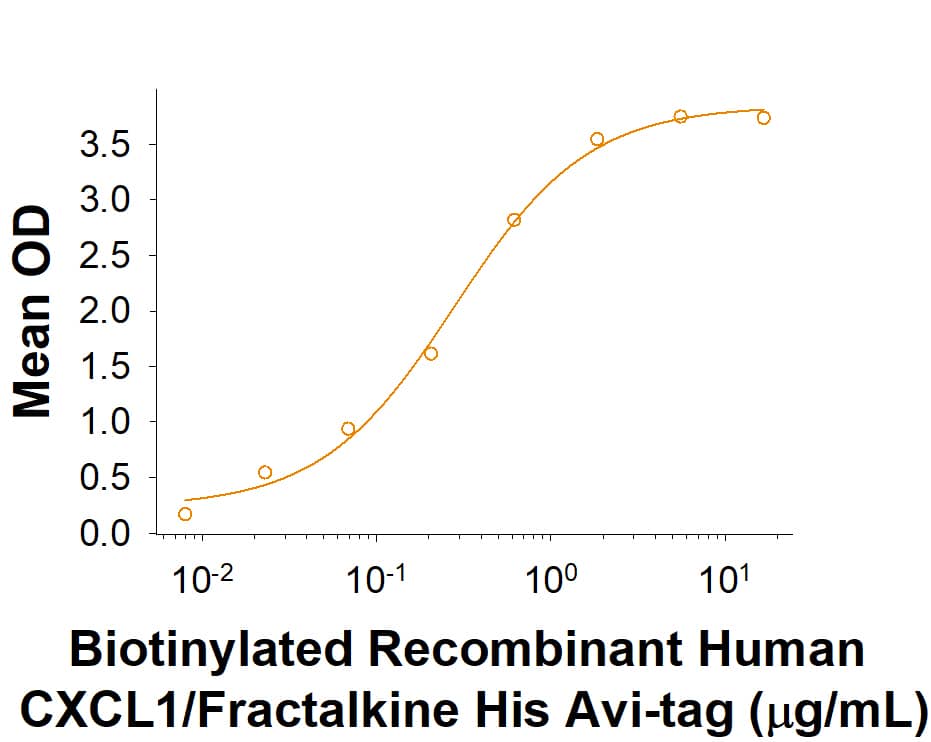Recombinant Human CX3CL1/Fractalkine His Avi-tag Protein, CF
R&D Systems, part of Bio-Techne | Catalog # AVI365
Biotinylated

Key Product Details
Learn more about Avi-tag Biotinylated Proteins
Source
HEK293
Accession #
Structure / Form
Biotinylated via Avi-tag
Conjugate
Biotin
Applications
Binding Activity, Bioactivity
Product Specifications
Source
Human embryonic kidney cell, HEK293-derived human CX3CL1/Fractalkine protein
| Human CX3CL1/Fractalkine (Gln25-Thr338) Accession # P78423.1 |
HHHHHH | Avi-tag |
| N-terminus | C-terminus |
Purity
>95%, by SDS-PAGE visualized with Silver Staining and quantitative densitometry by Coomassie® Blue Staining.
Endotoxin Level
<1.0 EU per 1 μg of the protein by the LAL method.
N-terminal Sequence Analysis
Gln25, inferred from enzymatic pyroglutamate treatment revealing His26
Predicted Molecular Mass
36 kDa
SDS-PAGE
88-103 kDa, under reducing conditions
Activity
Measured by its ability to chemoattract BaF3 mouse pro-B cells transfected with mouse CX3CR1.
The ED50 for this effect is 20-100 ng/mL.
Measured by its binding ability in a functional ELISA.
The ED50 for this effect is 20-100 ng/mL.
Measured by its binding ability in a functional ELISA.
When Recombinant Human CX3CL1/Fractalkine monoclonal antibody
(Catalog #
MAB3651)
is immobilized at 1 µg/mL (100 µL/well), Biotinylated Recombinant Human CX3CL1/Fractalkine His-tag Avi-tag binds with ED50 of 0.15-0.9 μg/mL.
Scientific Data Images for Recombinant Human CX3CL1/Fractalkine His Avi-tag Protein, CF
Recombinant Human CX3CL1/Fractalkine His Avi-tag Protein Binding Activity
When Human CX3CL1/Fractalkine MAb MAB3651) is immobilized at 1 µg/mL (100 µL/well), Biotinylated Recombinant Human CX3CL1/Fractalkine His-tag Avi-tag binds with an ED50 of 0.15-0.9 µg/mL.Recombinant Human CX3CL1/Fractalkine His Avi-tag Protein SDS-PAGE
2 μg/lane of Biotinylated Recombinant Human CX3CL1/Fractalkine His-tag Avi-tag Protein (Catalog # AVI365) was resolved with SDS-PAGE under reducing (R) and non-reducing (NR) conditions and visualized by Coomassie® Blue staining, showing bands at 88-103;kDa.Formulation, Preparation and Storage
AVI365
| Formulation | Lyophilized from a 0.2 μm filtered solution in PBS with Trehalose. |
| Reconstitution | Reconstitute at 500 μg/mL in PBS. |
| Shipping | The product is shipped at ambient temperature. Upon receipt, store it immediately at the temperature recommended below. |
| Stability & Storage | Use a manual defrost freezer and avoid repeated freeze-thaw cycles.
|
Background: CX3CL1/Fractalkine
References
- Poniatowski, L. et al. (2017) Mol. Neurobiol. 54:2167.
- Desforges, N. et al. (2012) Int. J. Alzheimers Dis. 2012:345472.
- Nanki, T. et al. (2016) Mod. Rheumatol. 27:392.
- Liu, W. et al. (2016) Arch Immunol. Ther. Exp. (Warsz) 64:371.
- Zlotnik, A. Yoshie, O. (2012) Immunity 36:705.
- Quan, Z. et al. (2017) Current Gene Therapy 17:442.
Alternate Names
FKN, Fractalkine, Neurotactin
Gene Symbol
CX3CL1
UniProt
Additional CX3CL1/Fractalkine Products
Product Documents for Recombinant Human CX3CL1/Fractalkine His Avi-tag Protein, CF
Product Specific Notices for Recombinant Human CX3CL1/Fractalkine His Avi-tag Protein, CF
For research use only
